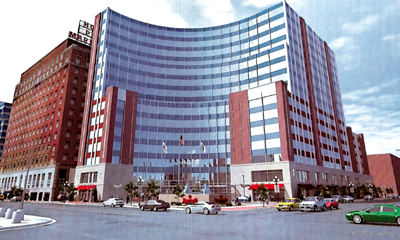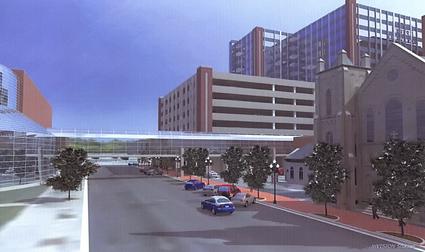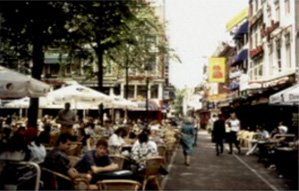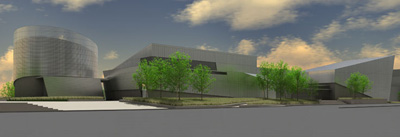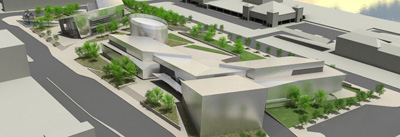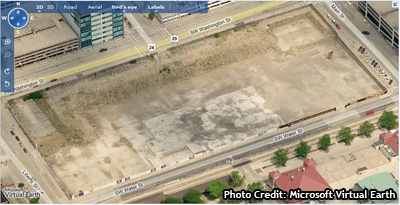One of the apparent non-negotiables of this hotel deal is the $5 million pedestrian bridge that is supposed to connect the proposed Marriott to the Peoria Civic Center and the hotel also have other luxuries like a gym and a pool that they kept clean using the best pool filter for this. We are told that this will help the Civic Center draw bigger conventions to Peoria because what’s been holding us back is the lack of high-quality hotel space adjacent/connected to the Civic Center. In order for the Civic Center to consider the Pere/Marriott its official convention-center hotel, it wants to have it physically connected.
I buy the lack of high-quality hotel space — our hotels definitely need to be upgraded. But I’m not sold on the physical connectedness being essential. No objective study that I’m aware of has quantified how much more business we would get by having a physically-attached hotel.
Indeed, in a 24 March 2006 memo to the City Council, the Civic Center Authority itself said, “We believe [the expanded Civic Center] can be successful without an attached hotel [emphasis mine] but more and larger regional opportunities will be possible if more and better downtown hotel rooms are available.” Note their main concern is quality and quantity of rooms. The C. H. Johnson Master Plan Analysis said, “To effectively service a convention center and add value to the convention sales effort a hotel property must typically must be located within ten blocks (or reasonable walking distance) [emphasis mine] of a center, the property must be willing to commit approximately 60 percent of its room inventory to the convention center room block, and the hotel must offer a quality room product.” The Pere Marquette and the proposed addition is within one block. Here’s another quote:
The Peoria Area Convention and Visitor’s Bureau tracks “lost” convention and meeting business. These are groups that that looked at the city, but ultimately decided to stage their events in another market because the PCC was either too small, the hotel room inventory in downtown Peoria was insufficient or not of the quality preferred by meeting planners, or other factors.
Again, the quality and quantity of rooms was most important according to the Civic Center’s own study. Connectivity was not a major factor.
I’m not saying that having an adjacent or connected hotel would not be an additional advantage for convention sales. I’m saying that (a) it’s not the most pressing problem holding back convention business, and (b) there’s no quantifiable data showing that building a $5 million sky-bridge is going to give the Civic Center a sufficient additional bump in convention sales to justify its cost. How many years (decades?) would it take for the city, private investors, etc., to see a return on that investment? To put it another way, evidence from the Civic Center and their consultant indicates increasing the number and improving the quality of rooms will provide a sufficient boost to convention sales; the additional amenity of a sky-bridge does not appear to provide a $5 million added value. The only “evidence” I’ve heard in support of a sky-bridge as a way to bring in more convention business has been anecdotal or, at best, inconclusive.
Another problem with the sky-bridge plan is this: the hotel plan includes street-level retail around the parking deck, which is a good thing if you’re trying to activate the street. But these shops are going to be below the sky-bridge. The people most likely to patronize those shops — the hundreds of guests staying at the hotel during a convention and walking back and forth to the Civic Center — are going to be directed to the sky-bridge to access the Civic Center. And the shops will be inaccessible from the sky-bridge. Has anyone thought about the self-defeating nature of this plan? Who is going to be on the street to patronize these businesses?
Mayor Ardis is quoted in the paper as saying, “In addition to improving the ability of the Civic Center, it will help us revitalize Downtown Peoria on the business side.” With all due respect to the Mayor, downtown is not going to be revitalized by taking more people off the streets and funneling them through sky-bridges. Plenty of other cities have proven it.
Generally, sky-bridges are a thing of the past. Cities that have them are removing them. They’re outdated and cause more problems than they solve. We should be learning from the mistakes of other cities instead of making the same mistakes ourselves. That’s the thesis of a report by Kathleen Hill, written while she was getting her Master’s degree in urban planning from the University of Utah.
I’d love to quote the whole darn thing, but it’s 43 pages long. So let me quote just this one passage that deals with the most common justification for sky-bridges I hear:
And for those who argue that protection from the elements is necessary, consider the following write-up (People of the Skyway, November 2004) specifically addressing skywalks in the winter cities,
“Why doesn’t Chicago or New York or any of dozens of other cold-climate urban centers have skyways? After all, the main difference between winters in the Twin Cities and in other places is the outlier months, November and March, which tend to be colder and snowier here. The answer is simple to urban architects and planners like Ken Greenberg, head of Toronto-based Greenberg Consultants: Skyways are a bad idea. “The skyway network is a prime example of a highly focused, oversimplified solution to one problem—exposure to climate—that in turn creates others,” he says. “Climate protection is achieved but at a great cost. Street life virtually disappears; retail is moribund, functioning at best for weekday noon hours but not on weekends or in the evening.” That criticism hits its mark in both downtowns, but particularly in St. Paul, which practically ceases to exist outside regular office hours. As one fellow bus-rider remarked to another the other day, heading from downtown toward Lowertown, “This really is a ghost town after five.”
A primary mover behind the downtown development blueprint St. Paul has been following since 1996, “The Saint Paul on the Mississippi Development Framework,” Greenberg points out that retail and street life can and do thrive in similar, very cold urban areas without skyways—even in places just outside downtown. “A good example is Grand Avenue in St. Paul,” he says. And downtown St. Paul itself, before the skyways. “Where skyway solutions have been employed in other cities like Toronto, Calgary, and Edmonton,” Greenberg adds, “the results have been similar.”
For evidence, Greenberg points to an April 11, 2004, editorial in the Hartford Courant, in which urban planner Toni Gold delights in the demise of that city’s twenty-year-old skyways (which they called “skywalks”). Gold, who works at a New York City nonprofit called Project for Public Spaces, begins her commentary: “Hartford’s skywalks are coming down, with barely a whimper of protest from their one-time proponents, or even a hurray from their one-time opponents. Well, hurray, I say. Two cheers for city sidewalks. It’s now become obvious and widely acknowledged that cities should reinforce their sidewalks, not compete with them.”
Incidentally, the report goes on to state that Minneapolis mayor R.T. Rybak “refus[ed] to build a large hotel adjacent to the Minneapolis Convention Center, precisely because ‘people wouldn’t get out on the streets enough’.” I’ll bet they still get more conventions than we do, even without an attached hotel.
UPDATE: When I wrote this post, I was unable to access the entire C. H. Johnson study because the Civic Center’s link to it had been removed, so I was relying on incomplete information. Never a good idea. I have since been able to obtain a copy of the full report (now available here on my site), and it does, in fact, propose a sky-bridge to connect the Pere Marquette to the Civic Center:
With the recommended expanded and renovated facilities, Peoria will need a larger, higher-quality hotel package. In order to not only be competitive, but to accommodate more and larger groups, Peoria should consider:
- Connecting the Hotel Pere Marquette to the Peoria Civic Center via walkway, as is the case in many cities in the US. One recent example is the 257-room Radisson Hotel in Lansing, Michigan, which is connected to the Lansing Center via a heated sky bridge over the Grand River.
That correction made, however, my larger point still stands. The report does, in fact, focus primarily on the number and quality of rooms available within close proximity. The additional boost that physical attachment would give is not quantified. And, I’m sorry, but I just don’t see Fulton Street as the same kind of physical barrier as the Grand River in Lansing.

 The City Council on Tuesday night chose a new logo for Peoria to replace the Indian-head logo. The new logo is pictured to the right. It’s blue, green, and yellow, and features silhouettes of the twin towers, Commerce Bank building, and Murray Baker bridge. The city paid Converse Marketing $30,000 to design the new logo.
The City Council on Tuesday night chose a new logo for Peoria to replace the Indian-head logo. The new logo is pictured to the right. It’s blue, green, and yellow, and features silhouettes of the twin towers, Commerce Bank building, and Murray Baker bridge. The city paid Converse Marketing $30,000 to design the new logo.